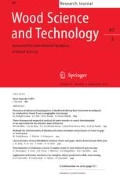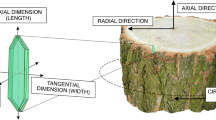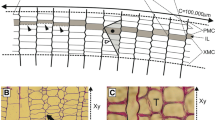Summary
Cavity formation in the S2 layer of the secondary cell wall by soft rot fungi is initiated following the establishment of a T-branch by the extension growth of a proboscis hypha. This growth is inhibited after a time and lateral dissolution of the cell wall takes place to form a cavity and enlarge the hypha within it until cavity and hypha are large enough or mature enough to overcome the inhibition to extension growth and a new proboscis hypha is formed and the process repeated. The pointed ends and restrictions to the cavities are brought about by the inhibition of enzyme activity at the ends of the proboscis hypha and the possible deposition of inhibitory material along the pointed ends of the cavity formed.
Similar content being viewed by others
References
Corbett, N. H. 1963. Anatomical, ecological and physiological studies on microfungi associated with decaying wood. Ph.D. Thesis, University of London
Corbett, N. H. 1965. Micro-morphological studies on the degradation of lignified cell walls by Ascomycetes and fungi imperfecti. J. Inst. Wood Sci. No. 14, 2 (2): 18–29
Corbett, N. H.; Levy, J. F. 1963. Penetration of tracheid walls of Pinus sylvestris L. (Scots pine) by Chaetomium globosum. Nature 198: 1322–1323
Crossley, A. 1975. A study (using electron microscopy) of brown, white and soft rots in wood. Third year undergraduate project thesis, Imperial College, London
Findlay, G. W. D. 1970. Microscopic studies on soft rot in wood. Ph.D. Thesis, University of London
Frey-Wyssling, A. 1938. Submikroskopische Struktur und Mazerationsbildner nativer Cellulosefasern. Papier-Fabrikant 36: 212
Fuller, D. B. 1970. Studies on the cellulolytic enzymes of some wood destroying fungi. Ph.D. Thesis, University of London
Jutte, S. M.; Wardrop, A. B. 1970. Morphological factors relating to the degradation of wood fibres by cellulase preparations. Acta Bot. Neerl. 19 (6): 906–917
Levi, M. P.; Preston, R. D. 1965. A chemical and microscopic examination of the action of the soft rot fungus Chaetomium globosum on Beechwood (Fagus sylvatica) Holzforschung, 19 (6): 183–190
Levy, J. F.; Stevens, M. G. 1966. The initiation of attack by soft rot fungi in wood. J. Inst. Wood Sci. No. 16, 2 (4): 14–24
Liese, W. 1970. The action of fungi and bacteria during wood deterioration. Rec. 1970 Ann. Conv. Brit. Wood Pres. Assoc., 81–97
Nilsson, T. 1974a. Formation of soft rot cavities in various cellulose fibres by Humicola alopallonella Meyers and Moore. Studia Forestalia Suecica. Nr. 112
Nilsson, T. 1974b. Microscopic studies on the degradation of cellophane and various cellulosic fibres by wood attacking microfungi. Studia Forestalia Suecica. Nr. 117
Roelofsen, P. A. 1956. Eine mögliche Erklärung der typischen Korrosionsfiguren der Holzfasern bei Moderfäule. Holz Roh- Werkstoff 14 (6): 208–210; (C.S.I.R.O. Translation No. 5132)
Sinner, M.; Parameswaran, N.; Yamazaki, N.; Liese, W.; Dietrichs, H. H. 1976. Specific enzymatic degradation of polysaccharides in delignified wood cell walls. Appl. Polymer Symp. 28: 993–1024
Wardrop, A. B.; Jutte, S. M. 1968. The enzymatic degradation of cellulose from Valonia ventricosa. Wood Sci. Technol. 2: 105–114
Zainal, A. S. 1975. Micro-morphological studies of soft rot fungi in wood. Ph.D. Thesis, University of London
Zainal, A. S. 1976a. The soft rot fungi: the effect of lignin. Mat. u. Org. Beih. 3: 121–127
Zainal, A. S. 1976b. The effect of a change in the cell wall constituents on decay of Scots pine by a soft rot fungus. Mat. u. Org. 11 (4): 295–301
Author information
Authors and Affiliations
Additional information
I wish to thank Dr. John F. Levy for his help and guidance throughout this work. I also acknowledge the encouragement and the enthusiasm of Professor R. D. Preston to publish this study. I am most grateful to the University of Kuwait in giving me leave of absence to carry out this work. My thanks are due to Alan Crossley for supplying me with the SEM micrograph of “proboscis hypha”.
Rights and permissions
About this article
Cite this article
Zainal, A.S. A new explanation for soft rot cavity formation in the S2 layer of wood cell walls. Wood Sci. Technol. 12, 105–110 (1978). https://doi.org/10.1007/BF00350816
Received:
Issue Date:
DOI: https://doi.org/10.1007/BF00350816




